12.3 Managing Disk Space Usage in the Post Office
Many users are prone to save every message and attachment they ever receive. You can moderate this behavior by implementing disk space management:
NOTE:The Cross-Platform client does not currently respect the mailbox size limits established in ConsoleOne.
12.3.1 Preparing to Implement Disk Space Management
If you are implementing disk space management in an existing GroupWise system, you must begin by setting the initial size information on all users’ mailboxes. If you are implementing disk space management in a new GroupWise system, skip to Section 12.3.2, Setting Mailbox Size Limits.
To establish current mailbox size:
-
In ConsoleOne, browse to and select a Post Office object.
-
Click > >
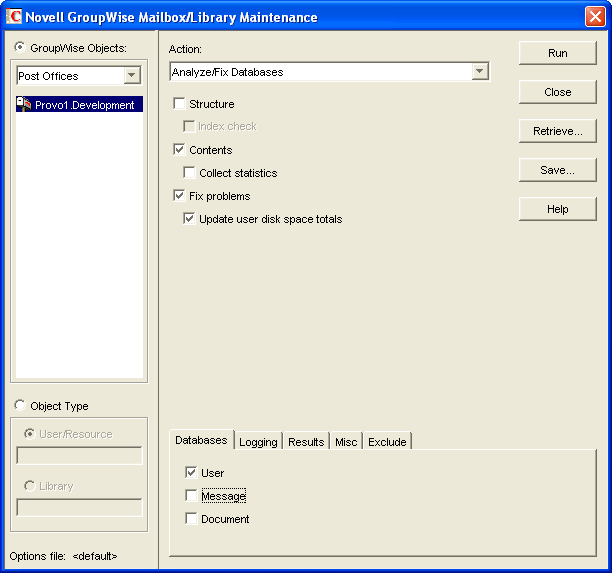
-
In the field, select .
-
In the field, select .
-
As options to the action, select , , and . Make sure all other options are deselected.
-
On the tab, select . Make sure all other types of databases are deselected.
-
Click , then click to acknowledge that the Mailbox/Library Maintenance task has been sent to the POA.
After the POA has performed the task, current mailbox size information becomes available on each user’s mailbox. The information is updated regularly as the user receives and deletes messages.
-
To generate a report of current mailbox information, follow the instructions in Section 30.1, Gathering Mailbox Statistics.
-
Repeat Step 1 through Step 8 for each post office where you want to implement disk space management.
-
Continue with Section 12.3.2, Setting Mailbox Size Limits.
12.3.2 Setting Mailbox Size Limits
After initial size information is recorded on each user’s mailbox, you can establish a limit on the amount of disk space each user’s mailbox is allowed to occupy. You can set a single limit for an entire domain. You can set different limits for each post office. You can even set individual user limits if necessary.
If you are implementing disk space management in an existing GroupWise system where users are accustomed to unlimited disk space, you should warn them about the coming change. After you establish the mailbox size limits as described in this section, users whose mailboxes exceed the established limit cannot send messages until the size of their mailboxes is reduced. Users might want to manually delete and archive items in advance in order to avoid this interruption in their use of GroupWise.
To establish mailbox size limits:
-
In ConsoleOne, browse to and select a Domain, Post Office, or User object.
-
Click > > .
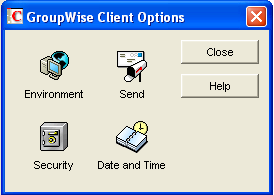
-
Click > .
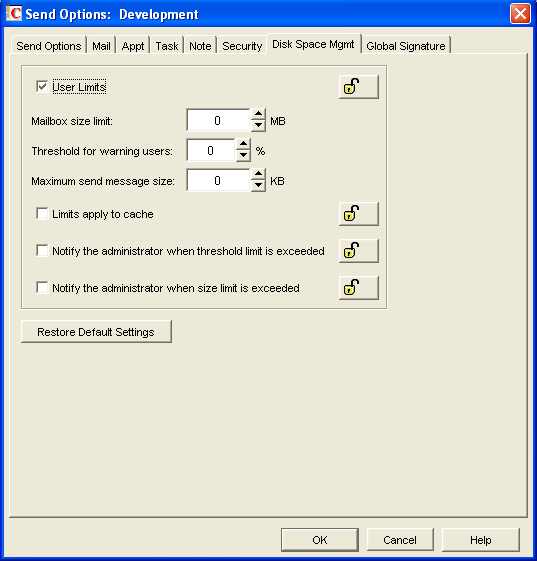
-
Select .
-
Specify the maximum number of megabytes allowed for each user’s mailbox.
Unless disk space is extremely limited, 200 MB is a comfortable mailbox size to enforce. The maximum size limit that you can set for mailboxes is 4 GB. However, GroupWise databases themselves have no inherent maximum size limit.
-
Specify as a percentage the point where you want to warn users that their mailboxes are getting full.
Users can continue to send messages until the size limit is reached. After the size limit is reached, users must reduce the size of their mailboxes in order to send additional messages.
-
Optionally, specify in kilobytes the largest message that users can send.
By restricting message size, you can influence how fast users’ mailboxes fill up. However, if users have valid reasons for sending messages that exceed this limit, the limit can become a hindrance to users getting their work done.
-
Click > to save the disk space management settings.
-
If you are adding disk space management to an existing GroupWise system where users’ mailboxes are already over the desired size limit, continue with Section 12.3.3, Enforcing Mailbox Size Limits.
or
If you are implementing disk space management in a new system where users have not yet begun to use their mailboxes, see
Using Mailbox Storage Size Information
inManaging Your Mailbox
in the GroupWise 7 Windows Client User Guide to see how setting a mailbox size limit affects users’ activities in the GroupWise client.
12.3.3 Enforcing Mailbox Size Limits
If existing GroupWise users are having difficulty fitting their mailboxes into the established mailbox size limits, you can assist them by reducing their mailboxes for them. Users should be warned before this action is taken.
-
In ConsoleOne, select a Post Office object.
-
Click > > .
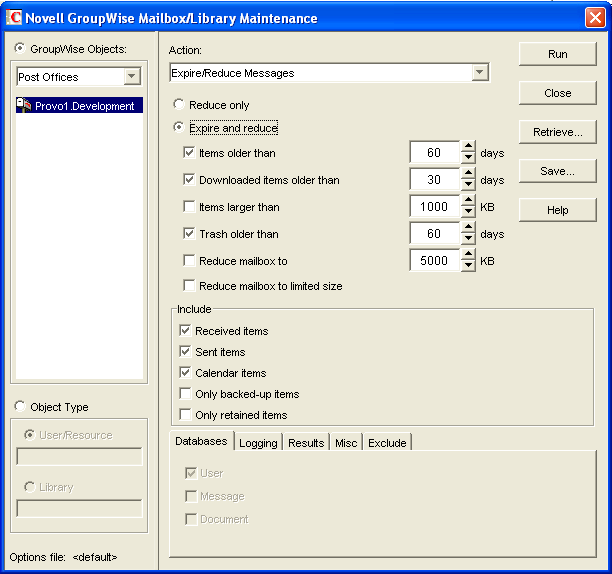
-
In the field, select .
-
Set the and options as desired, making sure that is selected.
-
Click , then click to acknowledge that the Mailbox/Library Maintenance task has been sent to the POA.
After the POA has performed the task, users mailboxes fit within the mailbox size limit you have established.
-
Repeat Step 1 through Step 5 for each post office where you want to reduce user mailboxes to the established mailbox size limit.
See Using Mailbox Storage Size Information
in Managing Your Mailbox
in the GroupWise 7 Windows Client User Guide to see how setting a mailbox size limit affects user activities in the GroupWise client.
12.3.4 Restricting the Size of Messages That Users Can Send
By restricting message size, you can influence how fast user mailboxes fill up. However, if users have valid reasons for sending messages that exceed this limit, the limit can become a hindrance to users getting their work done.
For HTML-formatted messages, the MIME portion of the message counts in the message size. MIME files can be large. If a user cannot send an HTML-formatted message, he or she could use plain text instead, in order to decrease the size of the message so that it falls within the message size restriction.
There are four levels at which you can restrict message size:
NOTE:Although the Cross-Platform client does not enforce the message size limits established in ConsoleOne using > > > > , messages originating from the Cross-Platform client can be restricted by the POA and MTA as they pass between post offices and domains.
Within the Post Office
You can use Client Options to restrict the size of messages that users can send within their local post office.
-
In ConsoleOne, browse to and select a Domain, Post Office, or User object.
-
Click > > .

-
Click > .

-
Select .
-
Specify in kilobytes the largest message that users can send.
-
Click , then click to save the maximum message size setting.
Between Post Offices
You can configure the POA to restrict the size of messages that it allows to pass outside the local post office. See Section 36.2.8, Restricting Message Size between Post Offices for setup instructions.
Between Domains
You can configure the MTA to restrict the size of messages that it allows to pass outside the local domain. See Section 41.2.1, Restricting Message Size between Domains for setup instructions.
Between Your GroupWise System and the Internet
You can configure the Internet Agent to restrict the size of messages that it allows to pass to and from your GroupWise system by setting the size limits in a customized class of service. See Section 47.1, Controlling User Access to the Internet for setup instructions.
12.3.5 Preventing the Post Office from Running Out of Disk Space
In spite of the best disk space management plans, it is still possible that some unforeseen situation could result in a post office running out of disk space. To prevent this occurrence, you can configure the POA to stop processing messages, so that disk space usage in the post office cannot increase until the disk space problem is resolved.
-
In ConsoleOne, double-click a Post Office object, right-click its POA object, then click .
-
Click > , then adjust the settings in the and fields as described in Section 36.4.2, Scheduling Disk Space Management.
-
Click > .
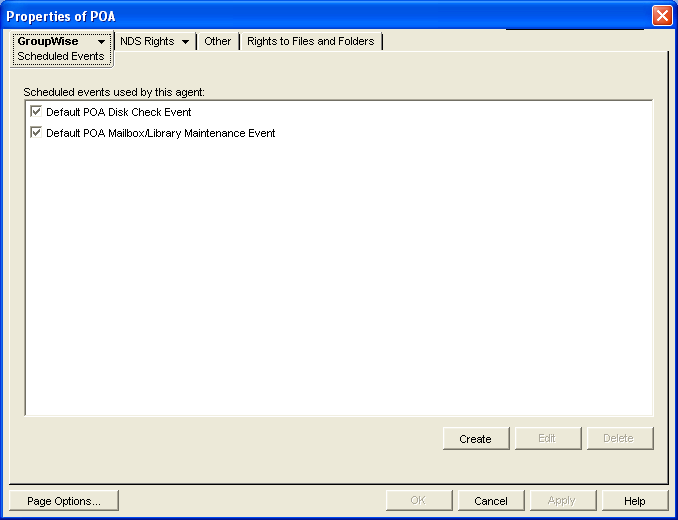
-
Click to create a new scheduled event to handle an unacceptably low disk space condition.
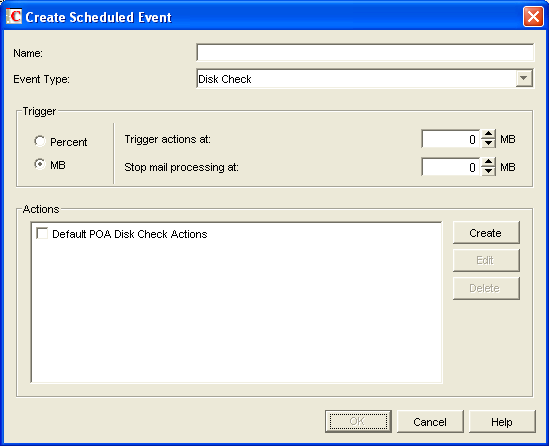
-
Type a unique name for the new scheduled event, then select as the event type.
-
In the field, specify the amount of free post office disk space at which to take preventive measures.
-
Click to define your own disk check actions, then give the new action a unique name.
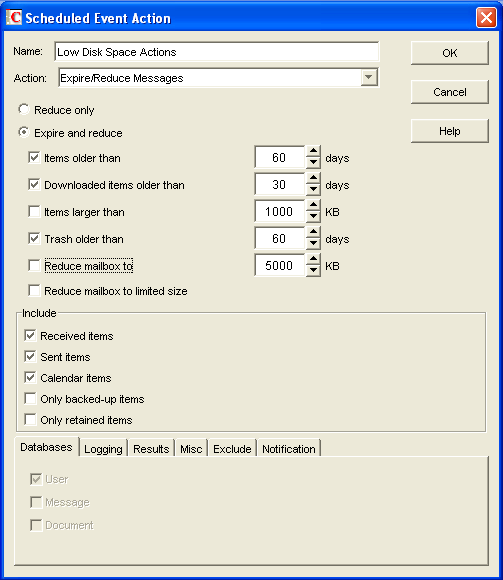
-
Configure the actions for the POA to take in order to relieve the low disk space condition.
Use the or tab if you want to receive notification about the POA’s response to the low disk space condition.
-
Click to return to the dialog box.
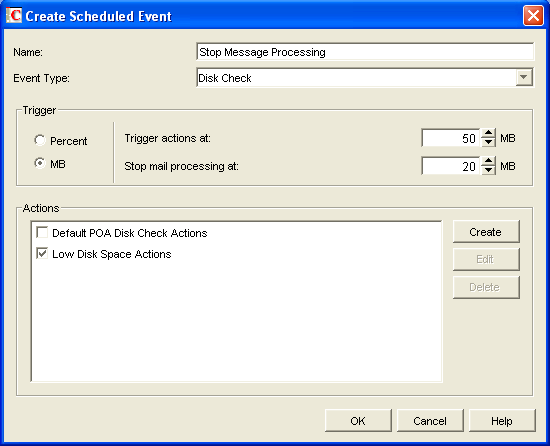
For additional instructions, see Section 36.4.2, Scheduling Disk Space Management.
-
Select the new set of actions.
-
In the field, specify the amount of free post office disk space at which you want the POA to stop processing messages.
-
Click to create the new disk space management event and return to the page.
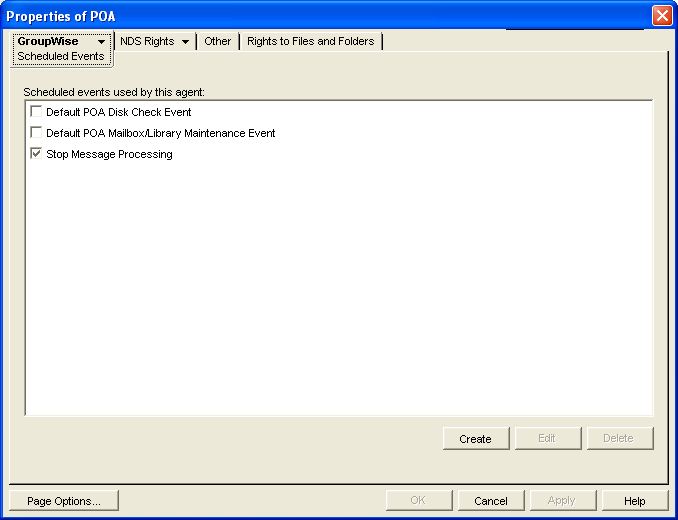
-
Select the new disk space management event.
-
Click to close the Scheduled Events page.
ConsoleOne then notifies the POA to restart so the new disk space management event can be put into effect.
12.3.6 An Alternative to Disk Space Management in the Post Office
If you want to place more responsibility for disk space management onto GroupWise client users, you can require that they run the client in Caching mode, where all messages can be stored on user workstations, or other personal locations, rather than in the post office. For an overview of Caching mode, see:
IMPORTANT:Do not force Caching mode for a post office that supports Outlook* clients along with GroupWise clients.
12.3.7 Forcing Caching Mode
You can force Caching mode for an entire domain. You can force Caching mode for specific post offices. You can even force Caching mode for an individual user if necessary.
When you initially force caching mode, users’ Caching mailboxes are identical with their Online mailboxes. However, as you employ disk space management processes in the post office and reduce the size of users’ Online mailboxes, more and more of the users’ mailbox items exist only in their Caching mailboxes. Make sure that users understand their responsibilities to back up their Caching mailboxes, as described in:
To force Caching mode:
-
In ConsoleOne, browse to and select a Domain, Post Office, or User object.
-
Click > > .

-
Click > .

-
In the box, select .
-
Click , then click to save the Caching mode setting.
If you are helping existing users, who might have sizeable mailboxes, to start using Caching mode exclusively, you can configure the POA to respond efficiently when multiple users need to download their entire mailboxes for the first time. See Section 36.2.7, Supporting Forced Mailbox Caching for setup instructions.